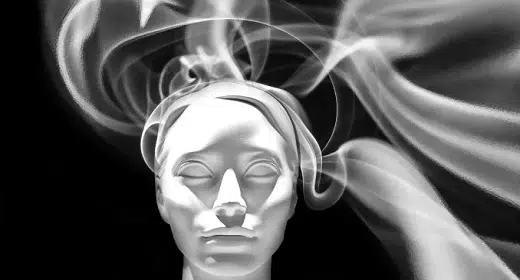The first step to liberation is ensuring that you have an appropriately qualified mind…
The primary means of achieving this is karma yoga.
It’s no use sitting down to meditate once or twice a day in the vain hopes of getting free. Your entire life must be reoriented, and karma yoga is the means of doing that.
For the samsari, who seeks happiness in external objects and experiences, action is determined by his or her likes and dislikes, and performed with attachment to the results.
The karma yogi, on the other hand, is no longer driven by the desire to achieve specific material ends.
As a karma yogi, your primary goal is moksha; freedom from emotional dependency on objects.
You act not according to your likes and dislikes but according to dharma. You do what is to be done when it is to be done, offering every action to Ishvara withgratitude and devotion.
Recognising Ishvara as the giver of the results of action, you then accept whatever results come as legitimate and proper; taking every outcome as prasada, a divine gift.
When performed in conjunction, dharma and karma yoga relieve stress like nothing else. Grief over the past and anxiety about the future melt away when you cease living your life solely for yourself, but as an offering to Ishvara.
As a seeker of liberation, this is your primary sadhana (spiritual practice).
By performing action in accordance with dharma and the karma yoga mindset, the vasanas are gradually rendered non-binding. This purifies the mind, rendering it fit for liberation through the application of Self-knowledge.

The 3 Stages of Vedanta
Vedanta is the ultimate medicine—the remedy to the sorrows of samsara.
This pramana, or means of knowledge, is essentially a tool for acquiring and assimilating the knowledge, “I am awareness.”
It works in a systematic three stage process.
There’s no skipping any of these stages and each must be taken in sequential order.
- Listening (Sravana). The first stage is called sravana, which means ‘hearing’. Having taken steps to qualify your mind through the practice of karma yoga, your next step is to find a qualified Vedanta teacher and consistently expose your mind to the knowledge. You do this by clearing your mind of preconception and prejudice, and simply listening to the teacher as he or she unfolds the teaching from beginning to end.
- Reflection (Manana). It’s not enough to simply hear the teaching. Even a parrot can listen to and repeat words. For Vedanta to work, you must fully understand and integrate the teaching on all levels. This necessitates working through any doubts, confusion or areas of misunderstanding that might arise, with the help of the teacher.
- Integration (Nididhyasana). Stage one begins with words. Stage two converts those words to knowledge. Stage three converts that knowledge to conviction. Nididhyasana takes the form of sustained contemplation and reflection on the teaching. You now know that the “I” belongs not to the body-mind-ego, but to the awareness in which all forms and experiences arise. For Self-knowledge to translate to moksha, you must own who you are by fully assimilating and internalising the knowledge, “I am awareness”.
The Importance of Vedantic Meditation
Vedantic meditation is the art of reconditioning the mind to identify with the true Self; pure awareness or consciousness. By keeping your attention fixed upon your nature as awareness, you effortlessly reorient the mind to its natural state of peace and wholeness.
In Panchadasi, Vidyaranya Swami says:
One should repeatedly meditate on the idea, “I am awareness”.
In concurrence, the Yoga Vasistha states:
This is the supreme meditation, the supreme worship; the continuous and unbroken awareness of the indwelling presence, inner light, or consciousness.
While you can gain an intellectual understanding of the teaching during the first stage by simply listening to the teacher, there’s a difference between mere understanding and assimilated knowledge.
It’s insufficient simply knowing about the Self.
Until this knowledge is integrated into every aspect of the psyche, your previous emotional and psychological problems will remain.
The fruits of Self-Knowledge rarely ripen immediately. After all, you’re dealing with a mind subject to decades and, indeed, lifetimes of ignorance.
The effects of this ignorance—which manifest as your thoughts of self-limitation and self-rejection, as well as desire, anger, frustration and grief—will not disappear overnight.
Until the knowledge that you are the Self is fully integrated and becomes a living, breathing reality for you, these ‘knots of the heart’ remain.

The Man Who Thought He Was a Worm
There’s a story which perfectly illustrates the importance of nididhyasana.
It’s about a man who thought he was worm.
This otherwise perfectly ordinary fellow went through life believing himself to be inferior to everyone else.
The idea that he was a wriggling worm not only caused terrible self-esteem problems, but also gave him an overwhelming fear of birds. Birds, after all, eat worms.
Whenever he stepped outside, the mere hint of a bird twittering was enough to strike mortal dread into his heart.
One day, a concerned friend decided that enough was enough. He told the man that he couldn’t go on like this, and that he had to get help.
His friend made a few phone calls, pulled some strings, and got the man booked into a highly renowned mental health institution.
There, the man received excellent care.
Every day he met with a skilled psychologist who eventually managed to convince him that he wasn’t a worm—but was, in fact, a human being like everybody else.
It took some time for the man to accept this. After all, he’d spent a lifetime labouring under his delusion.
But as the truth began to sink in, he found himself overcome by a tremendous sense of relief and liberation. If he was really was a human being like everyone else, he had nothing to worry about, and could actually enjoy his life!
The last morning of his stay, he thanked his doctor profusely, a tear of gratitude in his eyes.
He then checked out and stepped outside, ready to take on the world.
Until, that was, he caught sight of a bird sitting in a nearby tree—a big black crow, silently eyeing him.
Overcome by blind panic, he dashed back into the hospital and raced all the way to his psychologists’s office.
He shouted as he banged at the door, his heart racing and his skin covered in a cold sweat.
The doctor came out, astonished. “Whatever is the matter?”
“There’s a bird out there!” The man cried, his entire body trembling. “It—it was looking at me!”
The doctor frowned. “But we’ve been through this again and again. You don’t have to worry about birds now. You’re not a worm—you’re a human!”
“You know that,” the man said, “and I know that—but the bird doesn’t know that!”
The moral of the story is simple.
When you’ve spent your entire life thinking of yourself a certain way, it’s going to take time and effort to shift out of that way of thinking.
Habitual patterns of thought rarely change overnight. Even once you’ve seen an illusion for what it is, the aftereffects of fear and suffering may remain for some time.
Another helpful analogy is our earlier example of the prince who had spent his life as a beggar. When the king’s men eventually find him and tell him who he really is, he suddenly goes from being a penniless beggar to the richest man in the land.
Although his outer circumstances had changed in the blink of an eye, it may still take him some time to overcome his old ways of thinking. Inwardly, he may still see himself as a beggar; as a lacking person who has to worry about where the next meal is coming from.
To overcome this sense of limitation, he must own his new status by meditating on himself as a prince and not a beggar.
The same is true when it comes to Self-knowledge.
Unless your mind is highly qualified prior to sravana, the first stage of teaching, you won’t immediately enjoy the full benefits of Self-knowledge.
In all likelihood, you’ll still have certain blocks and obstructions preventing you from enjoying your nature as limitless, ever-free awareness.
Owing to your past thinking, you may still feel beggarly when, in fact, Self-Knowledge reveals you to be the king of all kings or queen or all queens.
How to Practise Nididhyasana
For this reason, nididhyasana is a vital step that cannot be skipped.
While the first two stages of teaching have a certain duration, either months or years depending on the student, the final stage, assimilating and integrating the teaching, has no set timespan.
In fact, nididhyasana should be practised for the rest of your life.
This prevents old habitual thought patterns from reasserting themselves and obscuring the knowledge that you are sat-chit-ananda: existence, consciousness and the bliss of fullness.
The first aspect of nididhyasana is learning to evaluate your life in the light of Self-knowledge.
Your old habits, thought patterns, values, relationships, activities, and ways of relating to others and the world must be re-evaluated in the light of Truth.
Anything that no longer serves you or which is incongruous with your identity as the Self—including adharmic habits that cause unnecessary agitation to your mind, body, or senses—should be weeded out.
The way that you live should be as close a reflection of who you truly are as possible.
When you realise your identity as the Self, you may notice that a lot of what was previously important to you—such as prior ambitions, goals, and the compulsive need to attain and acquire—simply falls away of its own accord.
Why would you continue seeking fullness in the world when you have finally found fullness in yourself? A jnani is one who feels happy in him or herself not because of external factors, but in spite of them.
The second component of nididhyasna is practicing Vedantic meditation, or contemplation upon the knowledge, ‘I am awareness’. Swami Paramarthananda calls this ‘self-opinion revision meditation’.
You came to Vedanta feeling like a lowly, inadequate jiva subject to the compulsions and sufferings of samsara.
Vedanta reveals this to be but a superimposition—an erroneous assumption caused by maya, which masks your true identity as the limitless, eternal Self.
Over time, you experience a shift of identity.
Whereas before you identified with the limited body-mind-ego, now you know yourself to be pure awareness; eternal and ever free from the limitations of name and form.
As we’ve established, however, it will likely take time until this reorientation of your identity becomes as natural to you as rattling off your name when someone asks who you are.
Until it does, you must consciously apply self-inquiry to any self-limiting thought, negative self-opinion or misplaced identification as and when they arise in the mind.
Any time you find yourself identifying as a jiva, as a wanting, grasping ego, you must get to the root of that ignorance and substitute it with a thought of truth; a thought of the Self.
Vedantic meditation focuses your attention on the object of meditation—your own Self.
You fix your mind on the teaching over and over again until Self-knowledge becomes firm conviction.
Continued and sustained reflection on your identity as the Self, as the field of awareness in which all objects and experiences arise, will in time shift your identity from the finite jiva to the infinite Self.













































